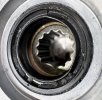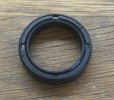Actually, having given this some more thought, I’m talking rubbish. You can see that the lip seal is installed into the shift motor the ‘wrong way round’ i.e. the front of the seal first, because it’s there to prevent the transfer box fluid tracking into the shift motor, not to prevent the fluid leaking out of the casing.
The O-ring prevents the fluid reaching the outside world. It’s the O-ring that you need to concentrate on (unless, of course, the shift motor is filling up with fluid). Sorry for the misleading information.
Phil
No apologies necessary, you have now (and in the past) been a gentleman and an amazing source of information, to myself and to many other people over many years.
In the year that I've had my L322 I have read many forums online to solve both small and large problems on my car.
Many times your posts have appeared in the information I was searching, going back to posts from many years ago.
You have always given people the information that you knew, that was only specific to their problem, without forcing opinions on them.
And you have many times sent people items that they needed to fix their problems!
After reading your comment here I realized that I should have also come to the same conclusion, because it is quite obvious.
It may be that the seal on my actuator motor is perfect and not need replacing.
Given some of the ridiculous things that the previous owner of the car (who had it for 20 years) did, it may be that there is no O-ring there at all.
For example he removed the gearbox sump then used totally different bolts without the crimp washers, that were too long and were unable to be fully tightened because they hit the end of the holes in the housing that they were being tightened into (25mm vs 22mm).
Another example, I had a problem with my suspension and I found out that the rear ride sensor were both broken on the mechanical arms, and he had used cable ties at the elbow pivot to try to reconnect the mechanical arms.
There are many other examples of this type of bad repair or making unnecessary changes.
I figure if I'm going to put my car up on ramps on the street outside my house, go under it on my shop trolly, drain the transfer case, pull off the actuator, resolve the leak, put it back on, and fill up my transfer case again, I might as well have as many parts ready as I can.
I have not yet used the low range gear so I do not know if the actuator works, but I have not seen any errors from the actuator, on my OBD reader or on the instrument cluster, so it is unlikely that the actuator is full of oil.
Given how difficult it may be to get the seal, versus getting the O-ring, and based on your logical analysis of the purpose of the seal, it makes sense for me to order an O-ring, take off the actuator and see what I discover.
I doubt that I would damage the seal in this process, based on photo that I have seen of the actuator and how it fits with the transfer case, so I'm happy to proceed this way.
If I have any problems finding an O-ring I will let you know but for now I think you should keep the one that you have just in case.
I will let you know how it goes and take some picture and post them here.
Thank you again for your help.


















